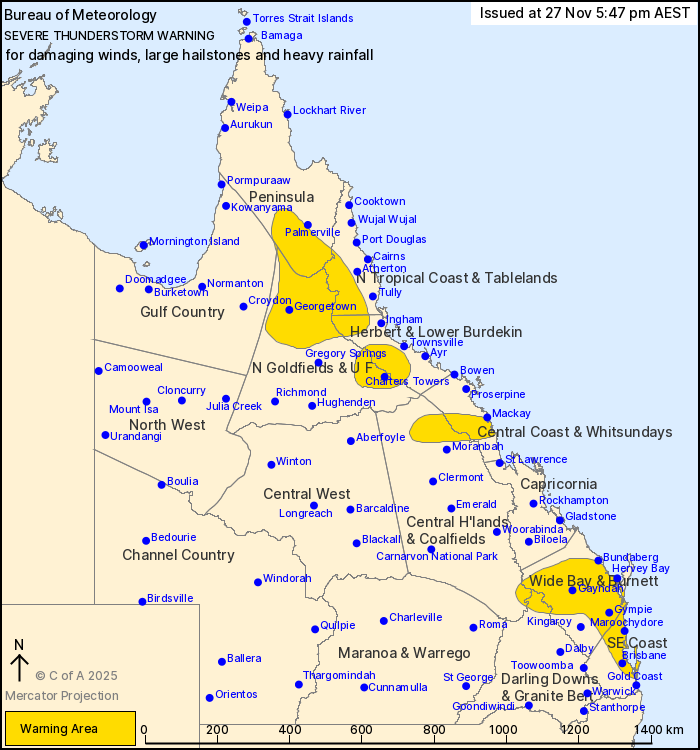Source: Bureau of Meteorology
For people in parts of Peninsula, North Tropical Coast and
Tablelands, Northern Goldfields and Upper Flinders, Herbert and
Lower Burdekin, Central Coast and Whitsundays, Central Highlands
and Coalfields, Wide Bay and Burnett, Darling Downs and Granite
Belt, Southeast Coast and Gulf Country Forecast Districts.
Issued at 5:47 pm Thursday, 27 November 2025.
Severe thunderstorms continue for parts of northern and eastern
Queensland.
Weather Situation: Moisture and instability persist to the east of
a surface trough through eastern Queensland, resulting in a broad
risk of severe thunderstorms. About the southeast this trough is
forecast to push offshore during the early evening.
Severe thunderstorms are likely to produce damaging winds, large
hailstones and heavy rainfall that may lead to flash flooding over
the next several hours in parts of the Central Coast and
Whitsundays, Central Highlands and Coalfields, Wide Bay and
Burnett, Darling Downs and Granite Belt and Southeast Coast
districts. Locations which may be affected include Brisbane,
Maroochydore, Gympie, Gayndah, Moreton Island and Rainbow
Beach.
Severe thunderstorms are likely to produce heavy rainfall that may
lead to flash flooding over the next several hours in parts of the
Peninsula, North Tropical Coast and Tablelands, Northern Goldfields
and Upper Flinders, Herbert and Lower Burdekin and Gulf Country
districts. Locations which may be affected include Charters Towers,
Georgetown, Mingela, Forsayth, Einasleigh and Mount Garnet.
Severe thunderstorms are no longer occurring in the Capricornia
district and the warning for this district is CANCELLED.
59 mm of rainfall recorded at Yammanie Minnamoolka in the 1 hour
to 4:16 pm.
3 cm hail reported in inner northern Brisbane suburbs around 3:20
pm.
52 mm of rainfall recorded at Mareeba in the 30 minutes to 2:24
pm.
57 mm of rainfall recorded at Fish Hole Creek in the 30 minutes to
12:45 pm.
Emergency services advise people to:
* Park your car undercover away from trees.
* Close doors and windows.
* Keep asthma medications close by. Storms and wind can trigger
asthma attacks.
* Charge mobile phones and power banks in case the power goes
out.
* Put your pets somewhere safe and make sure they can be
identified in case they get lost.
* Do not drive now unless you have to because conditions are
dangerous.
* Tell friends, family and neighbours in the area.
* Go inside a strong building now. Stay inside until the storm has
passed.

27/Nov/2025 08:16 AM



